Razer Blade 14 Review
Razer has been at the forefront of laptop design with its sleek Blade machines for years now. The Razer Blade fourteen is the company's kickoff 14-inch laptop and the offset Blade to sport an AMD processor. Using a Ryzen CPU should come as no surprise these days, but rather it was long overdue. This Bract locks and loads the Ryzen nine 5900HX, which is one of the best laptop processors around.
Our review unit has paired the 5900HX with GeForce RTX 3060 graphics and a 1080p display with a 144Hz refresh rate. It volition ready you lot back $one,799, and it'southward the well-nigh affordable of the three new Blades. The mid-range model keeps the 5900HX and upgrades to an RTX 3070 and a 165Hz brandish with a 1440p resolution for $2,199. While the priciest model deploys an RTX 3080 and costs $ii,799.
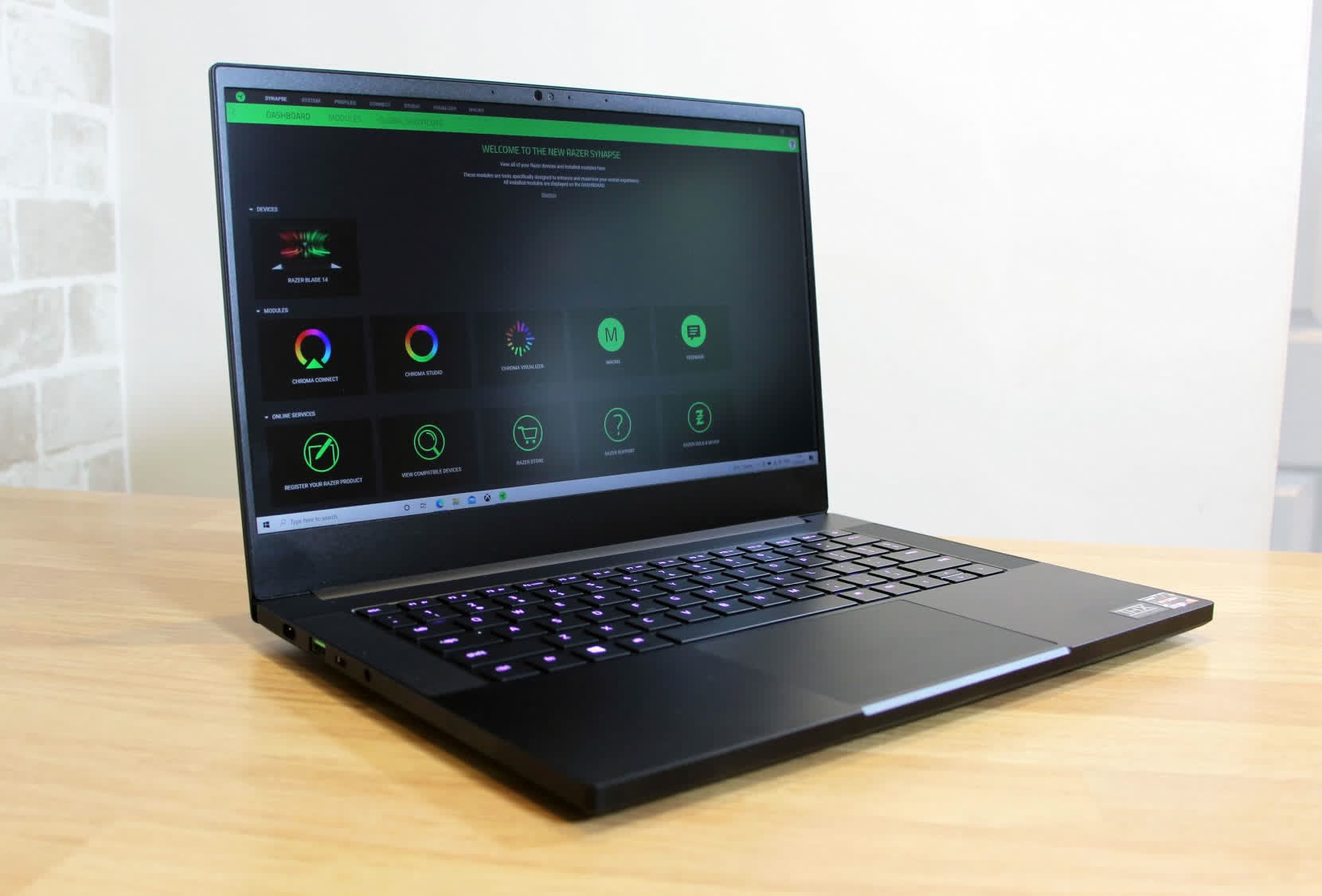
Features and Design
The 14-inch screen size might be new for Razer, but elsewhere this machine looks familiar – and that's no bad thing. The Blade fourteen uses the same CNC-milled aluminum construction we're used to see from other Razer machines, and information technology retains the clean lines, blackness finish, and slick shape of the rest of the range.
The Bract looks more like a black MacBook than a gaming laptop. The simply RGB LEDs are beneath the keyboard, and the only logo is the backlit Razer motif on the hat.
The Razer looks fantastic – and, every bit usual, it's well-built, likewise. There's inappreciably any movement at all in the metal base, and the brandish has only slight amounts of flex and no desktop baloney. It'due south easily stiff enough to be slung into a pocketbook, although you'll want a sleeve to avoid the exterior getting scuffed or scratched.

This Razer weighs three.92 pounds, and then it's relatively lightweight, although the hefty power brick increases that figure past 1.four pounds. The Blade's body is 320mm wide and 220mm deep, and but 16.8mm thick, although that latter figure does extend to 21mm thanks to the Blade's rubber anxiety.
Those are impressive figures given the hardware on offer, just don't brand it the slimmest or lightest 14-inch gaming laptop you can buy correct at present. The Asus ROG Zephyrus G14 is broader and deeper than the Razer, but it weights slightly less, and its power adapter only adds another pound on top of that. These figures are not deal-breakers in any way, especially for a light gaming notebook.
The Razer's correct-hand edge has single USB three.2 Gen 2 Type-A and Blazon-C ports. They both have 10Gbps of bandwidth, and the latter also serves up power delivery and DisplayPort 1.4 compatibility. There'southward an HDMI 2.ane port here, as well, which supports 8K/120Hz outputs – a handy bit of future-proofing, even if only small games and less-enervating esports titles will play at that resolution using the RTX 3060.
The left-paw border has the same USB Blazon-A and Type-C configuration alongside an audio jack and the automobile'due south power connector.
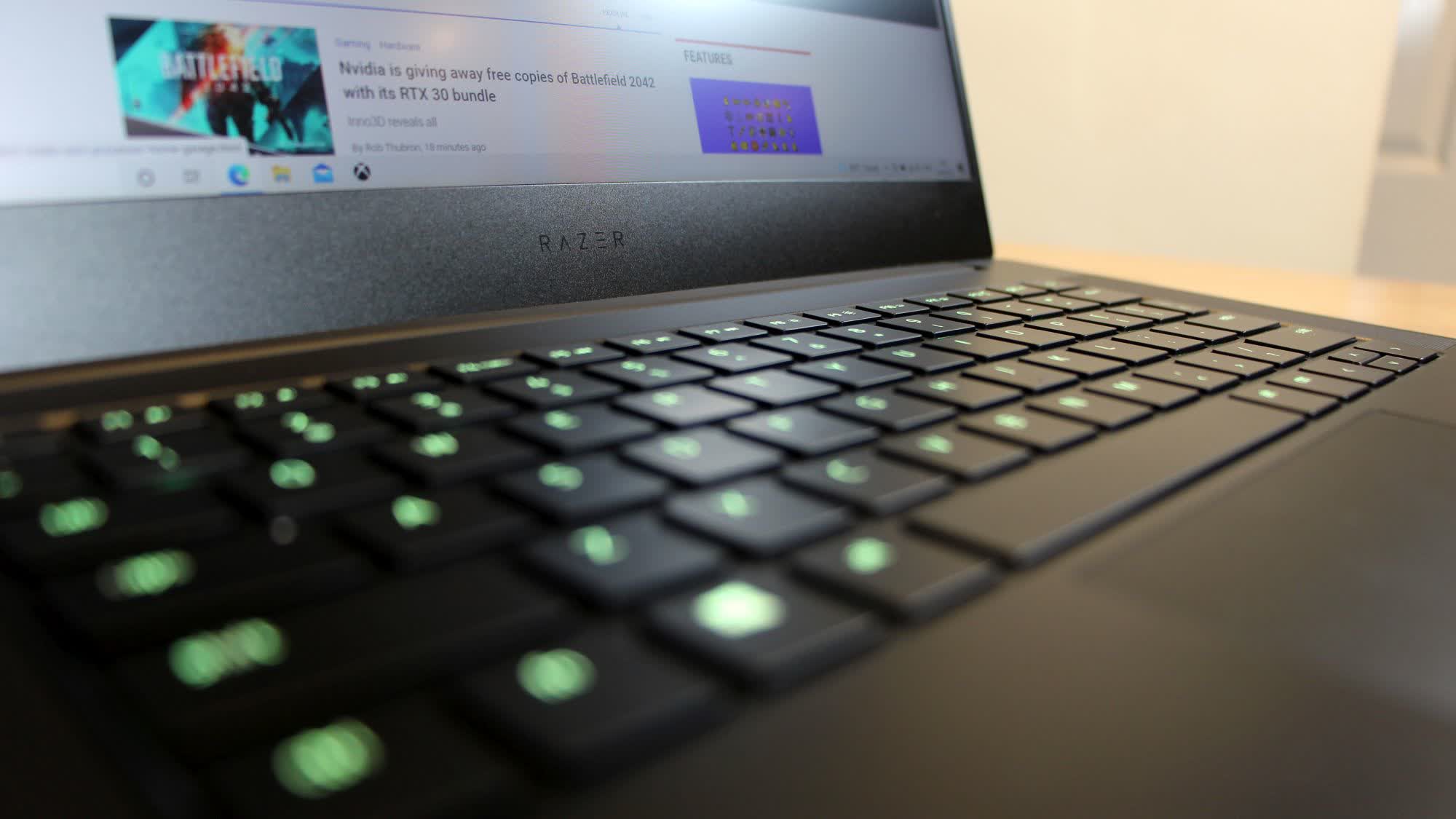
On the within, at that place'southward dual-ring 802.11ax Wi-Fi 6E and Bluetooth 5.2, and the Razer's feature set is rounded off by a Kensington Lock slot, TPM 2.0 security, and a 720p webcam with born Windows Hi. The camera'due south quality isn't dandy, but it's fine for video calls, and signing in with your face is a welcome boon.
It's a solid fix of features, but things are missing, too. There's no Gigabit Ethernet and no bill of fare or fingerprint readers. And, because this is an AMD laptop, there'due south no Thunderbolt. The main memory isn't upgradeable either.
The rival Zephyrus G14 isn't as expert in terms of connectivity. Merely one of its USB-C ports has DisplayPort and power delivery, and its HDMI two.0b port isn't as capable equally the Blade'southward HDMI ii.ane connector. Its USB 3.2 Gen 1 Type-A ports have one-half the bandwidth of the ports on the Blade. The Asus does have a fingerprint reader, but it doesn't have a webcam. And while it does take dual-band Wi-Fi 6, information technology doesn't have future-proofed 6E ability.
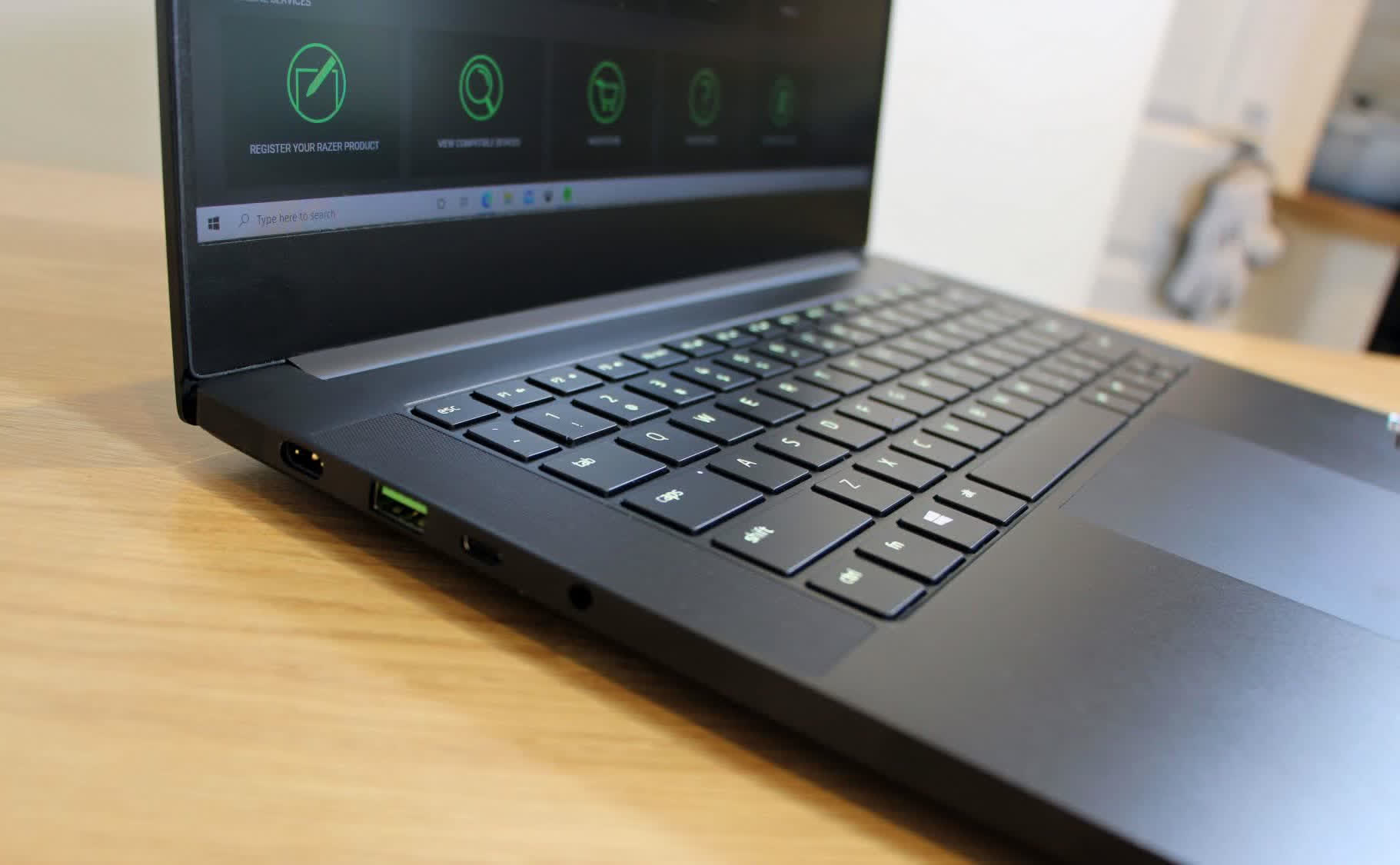
The Blade has a 14-inch IPS console with a 1,920 x 1,080 resolution, which means a density level of 157ppi. That'south excellent, and it means that games are pleasingly well-baked – although they're noticeably sharper on the pricier versions of this laptop, which apply a two,560 x ane,440 resolution for a density level of 210ppi.
Yet, there are plenty of pixels here for gaming, and the residual of the specification is good: AMD FreeSync bolsters the 144Hz refresh rate, so you lot become smooth gaming in mainstream situations, and the console has a matte terminate.
The backlight reaches a peak of 323cd/m2, which is bright enough to handle all indoor situations and well-nigh outdoor scenarios. The 0.17cd/m2 blackness betoken is skilful, too: improve than many other IPS displays and low enough to serve up lashings upwards depth and dash – darker colors are absorbing on this panel. The 1,900:1 contrast ratio is fantastic and better than most IPS displays. The vast contrast helps the panel deliver punchy, vibrant colors – combine this with the black signal, and you've got a brandish that makes games look bold and immersive.

The colors are decent, likewise. The Delta E of 1.66 ensures accuracy, and the Gamma level of ii.09 is pretty adept. The display's color temperature of 7,348K is a little on the cool side and as well far away from the 6,500K ideal figure. Just it's not a disaster – the colossal dissimilarity stops colors looking washed-out.
The Razer'due south console renders 93.ii% of the sRGB color gamut at 96.4% volume, then you get almost every shade required past modern, mainstream games. That'south a good effect – and overall, this is an fantabulous display – but this particular panel can't handle the Adobe RGB or DCI-P3 gamuts.
The 2,560 x i,440 screen included in the pricier Blade 14 models is noticeably meliorate. We accept as well tested that panel and nosotros could appreciate that in add-on to the higher resolution, it has a quicker 165Hz refresh rate. It renders more of the sRGB gamut with a higher volume, so colors look punchier. The 1440p display's dissimilarity ratio of 1,072:ane is adept, albeit not equally high as that on the 1080p screen, and so that's one area where the 1080p panel does have more depth – merely the 1440p panel isn't far enough behind in this section to go far a poorer experience. The resolution, refresh rate, and color ability help it make dorsum some footing.
The speakers are reasonable, simply non smashing. They've got a surprising corporeality of bass and enough volume to fill a bedroom, and top-end sounds are decent – but the mid-range is muddied. The Blade'due south audio kit tin can handle coincidental gaming and media, only a headset will provide a far better experience.
Razer'southward keyboard has customizable per-key RGB LED backlighting that is well-baked and bold. The keyboard has north-key rollover, and the buttons themselves are well-baked, fast, and consistent, so you'll have no problem getting up to speed in games.
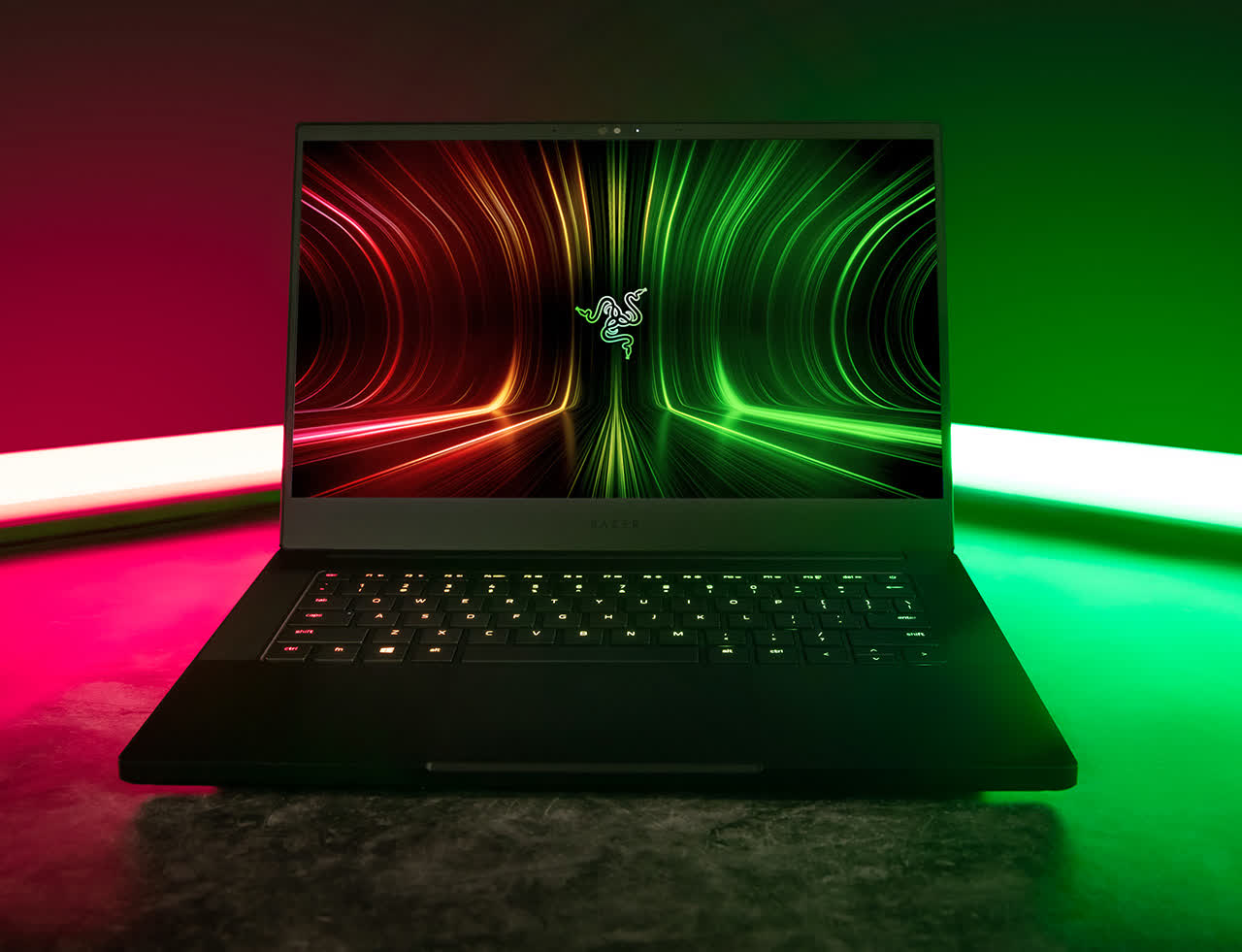
There are inevitable issues on a small laptop like this, though. While the buttons are fast and well-baked, they're shallow, so they lack the punch and weight that keen gamers oft prefer. This typing unit is fine for coincidental and mainstream games, just you'll undoubtedly discover larger and heftier keys on bigger notebooks. The Asus had a little more travel, besides, although its buttons are slightly softer.
There are layout compromises, likewise. The cursor keys are small, the Return key is single-pinnacle, and there'due south no number pad either. The trackpad is reasonably large, responsive, and fine for productivity and casual gaming, but a USB mouse will always be meliorate for playing.
As usual, the Razer Synapse app manages this automobile. Information technology's got modules for customizing the lighting and synchronizing it to other Razer devices, and the laptop tin exist easily switched between its balanced and boosted performance modes.
Performance
The RTX 3060 Laptop GPU inside the Bract has the usual 3,840 stream processors and 6GB of memory, and information technology runs with a TDP that runs between 90W and 100W. That's towards the top of the range for this core, and that translates to an entry-level base speed of 900MHz and a more than impressive heave pace of one,425MHz. On paper, this core is beefier than the RTX 3060 inside the Asus, which runs between 60W and 80W.
The Ryzen 9 5900HX is tremendous on paper, with viii multi-threaded cores alongside base and boost speeds of 3.3GHz and 4.6GHz – and the Zen 3 architecture. The residual of the specification is good but unsurprising: the Blade is kitted out with 16GB of dual-channel DDR4 memory clocked to 3,200MHz and a 1TB Samsung PM981a SSD that delivered solid read and write speeds of 3,544MB/s and 2,747MB/s.
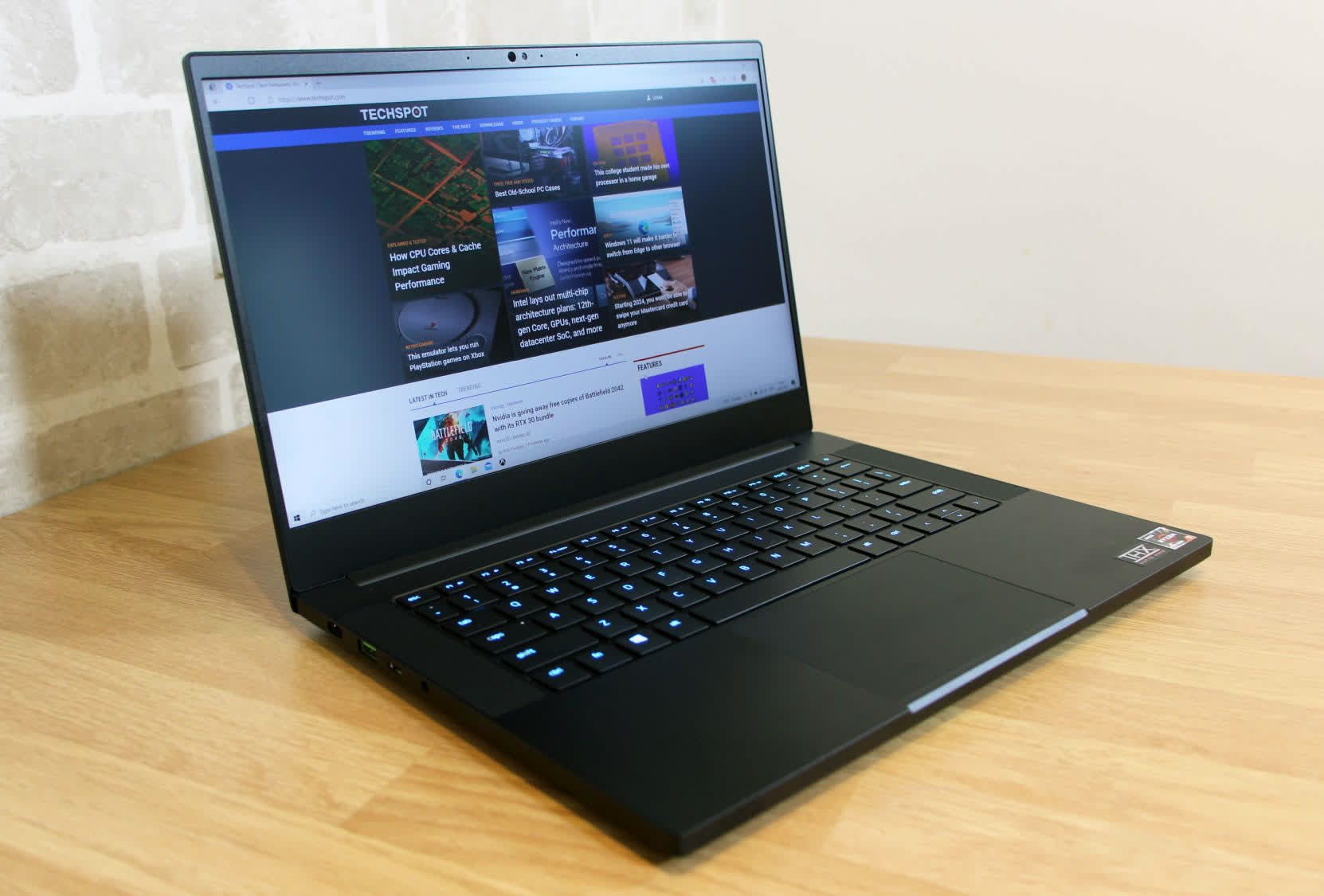
The Razer'southward RTX 3060 proved a capable performer in games benchmarks. Two of the most demanding games in our slate of tests are Scarlet Dead Redemption two and Assassinator'southward Creed Valhalla, and the Blade performed well in these titles. We ran Red Dead ii at High settings, and the Razer delivered minimum and average framerates of 35.7 fps and 64.8 fps, and in Valhalla's Very High settings the Bract ran at 39.iv fps and 55.3 fps. They're easily quick plenty to enable polish single-thespian gaming in the most demanding titles.
The Bract performed well in other games, too. It zipped through Shadow of the Tomb Raider'due south High settings at 52.4 fps and 92.9 fps, and averaged 58.4 fps with the game at maximum settings. Its minimum got beyond 60 fps in Far Cry: New Dawn at High settings and hit 54.1 fps at Ultra, and it delivered a nice 69.one fps in Borderlands iii.
There'due south enough ability here to play whatever of today's top single-histrion titles smoothly – you won't struggle to get across 60 fps at 1080p. And in Rainbow Six Siege, the Razer ran at 191.2 fps and 182.6 fps at Medium and Ultra settings, so this machine will easily handle esports games at the speeds required to sate the 144Hz display.
It's proficient operation, and the Blade's higher-power RTX 3060 will likely outpace the aforementioned chip inside the Asus. Information technology's non necessarily the fastest RTX 3060 nosotros've seen, though. In our deep-swoop GPU review we reviewed versions of the bit that ran between 80W and 95W alongside an Intel Cadre i7-10875H and betwixt 115W and 130W alongside an AMD Ryzen vii 5800H. In virtually of our benchmarks, those other RTX 3060 machines were faster than the Bract, with wider gulfs seen in minimum framerate tests.
New Dawn 1080p ultra 54.1/77.2 GTA 5 1080p max 4xMSAA 65.ii/97.4 Shadow of the Tomb Raider 1080p High SMAATx2 52.iv/92.9 Cerise Dead 2 1080p High, no AA, AF16x 35.seven/64.8 Valhalla 1080p Very High 39.iv/55.three Borderlands 3 1080p Ultra, DX11, fog/ssr medium 49.4/69.1
| 1080p Ultra settings (min / avg FPS) | Graphics Settings | |
| Far Cry New Dawn | 54 / 77 fps | Ultra preset |
| GTA V | 65 / 97 fps | Max preset, 4xMSAA |
| Shadow of the Tomb Raider | 52 / 92 fps | High preset, SMAATx2 |
| Ruddy Expressionless Redemption 2 | 35 / 64 fps | High, no AA, AF16x |
| Assassinator's Creed Valhalla | 39 / 55 fps | Very Loftier preset |
| Borderlands iii | 49 / 69 fps | Ultra, DX11, fog/ssr medium |
Other machines are quicker, but it's not a game-breaking stardom. A closer look at the GPU reveals that it runs at a 90W peak during its conventional operating modes and merely hits 100W with the heave options enabled. And while boost mode did improve the Blade's performance by a few frames, especially in the minimum framerate tests, it withal wasn't enough to assistance this laptop overhaul the RTX 3060 cores we've seen elsewhere.
The processor is impressive, although this is some other area where the silicon doesn't reach its total potential. In Cinebench R20 the Ryzen 9 5900HX returned unmarried- and multi-threaded scores of 560 and 4,240. The old score is around 20 points behind the performance we saw in our in-depth CPU review, while the latter falls effectually 700 points brusk. In the single-threaded test, the 5900HX is on par with the Ryzen 7 5800H and a little behind the newer Intel Core i7-11800H; in the multi-threaded benchmark, it's level with Intel and slower than the Ryzen seven CPU.
This pattern is visible elsewhere. The 5900HX took ten minutes and ten seconds to complete the Blender test – backside the Ryzen 7 and Ryzen ix chips tested elsewhere and simply slightly ahead of the Core i7. Its consequence of 1.55 in the Matlab R2020 test is slower than every other CPU mentioned hither, and information technology brutal behind the other CPUs in the Excel and PCMark 10 tests.
As with the graphics cadre, the Blade's CPU has a boost fashion to deploy actress speed. And it does deliver some additional performance: its Cinebench R20 multi-threaded outcome rose to 4,720, and the Blender issue improved past one minute. That helps, but that heave mode isn't perfect – the revised Cinebench multi-threaded result outpaced the Ryzen 7 and Cadre i7 chips merely even so couldn't match the best speed we've seen from the 5900HX, and the aforementioned was true in that additional Blender test.
The boost fashion didn't touch on single-threaded performance, either: the Bract's performance in the relevant Cinebench and Excel benchmarks didn't modify.

Equally ever, a clock speed test illustrates what'south going on. On paper, the Ryzen 9 5900HX can hit unmarried- and all-core heave speeds of 4.6GHz and 4.2GHz. But when running in its normal performance way the Razer could just manage unmarried and all-cadre boost speeds of four.5GHz and iii.5GHz. Using the boost choice saw the single-core speed remain at 4.5GHz, and it did improve the multi-core pace to three.9GHz, but it still leaves this particular 5900HX lagging behind a footling.
The CPU and GPU functioning compromises are no surprise in a thin and low-cal machine, but they exercise accept an impact on how you'll be able to use the Bract in day-to-day life, and you lot volition get better performance if you leave the fourteen-inch form factor behind.
If yous want to stick with the 14-inch Razer, you lot tin can pay more for the RTX 3070 or RTX 3080 versions, only they'll experience the same issues: those GPUs are faster, but they're both restricted to 100W TDPs too. Similarly, the 5900HX volition only fulfill its potential in a larger laptop, which comes with its own trade-offs. In this machine, it withal delivers lots of computing power: the slim Blade has more than enough speed for mainstream photo-editing and other content-cosmos tasks, and it'll tackle equally many Function apps and browser tabs every bit you want to throw at it.
And, while the Razer has been designed this way because of the slim, light chassis, the Bract is not a perfect thermal performer. Let'due south cover the good stuff first. If y'all're using the Blade to handle work tasks using its conventional performance mode, you're going to have a decent fourth dimension. In unmarried- and multi-threaded work tests the CPU never got beyond 82°C, and the outside remained comfortably cool. In these tests, the noise output peaked at 45db and 48db: not quiet, but not ruinously loud either. A headset or speakers will easily handle the noise, and information technology's not loud plenty to prove irritating.
If you use the CPU'southward performance boost mode in single-threaded situations then at that place'due south no difference to the noise and heat levels, but using this setting in a multi-cadre examination saw the CPU'south temperature rise to a hefty 100°C and the noise level ascension to 55db.
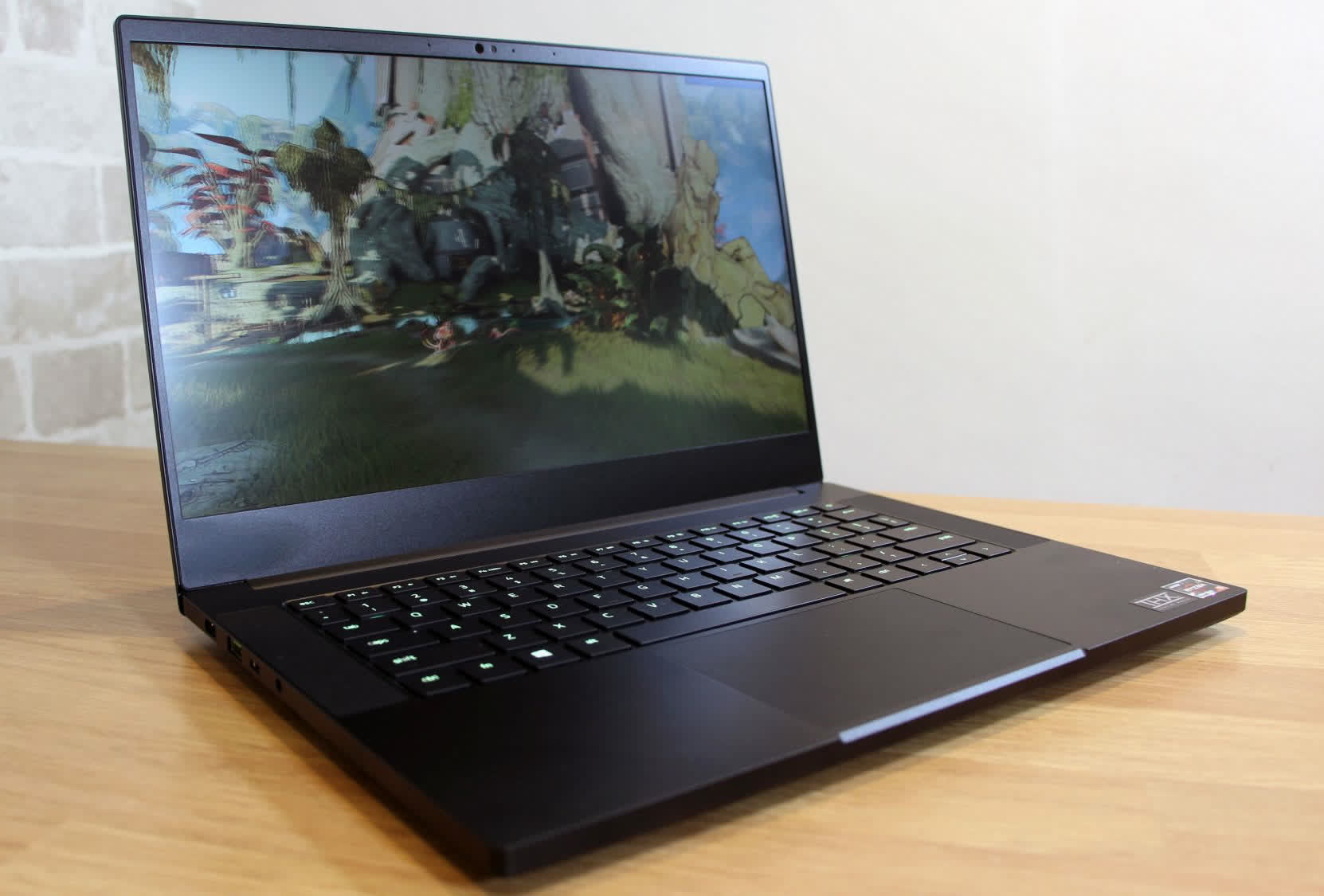
The Blade is a bit of a mixed bag when gaming, too. In its conventional performance mode the GPU'south temperature of 69°C is fine, and the noise level ranged between 53db and 56db. That'south not a disastrous noise level and y'all'll be able to drown it out with speakers or a headset, but this isn't the quietest auto when gaming either. Information technology's not the coolest laptop: the underside became slightly uncomfortable, and the metal above the keyboard was even hotter. When gaming in turbo style the noise level remained like, simply the exterior was even hotter. If you want to play games using this machine, we recommend using a desk-bound rather than your lap.
The Blade has a 61.1Wh battery that merely excels in certain situations. In a gaming test it lasted for just under one and a half hours, which is only average: last year'due south Asus G14 lasted for two hours and the latest model will likely hitting that aforementioned lifespan. If you want to play games using the Blade xiv then it's all-time to stay connected to a power source – and, given the exterior oestrus, best to place it at a desk.
In an everyday piece of work criterion the Blade fourteen lasted for 7 hours and 36 minutes, and it ran out of juice after a whopping 10 hours and 17 minutes when playing video. Halving the screen effulgence in both of those tests as well saw those results increase by around an hr. The Blade may not accept the juice to handle a long gaming session away from the mains, simply this machine tin tackle a full workday of Part applications and web-browsers, especially if y'all're careful with the backlight.
Who Is It For?
The Razer Bract xiv is a chip of an experiment but there'southward a lot to like here. The AMD processor is quick enough for virtually every mainstream content-creation task, and the 14-inch chassis is skillful-looking, sturdy, slim and light – and information technology has solid connectivity, too.
The RTX 3060 has the pace to tackle mainstream single-player and esports gaming, and the Blade delivers impressive battery life when running non-gaming workloads. The screen is vibrant, nuanced and has loads of depth, the keyboard is crisp and the speakers are reasonable.
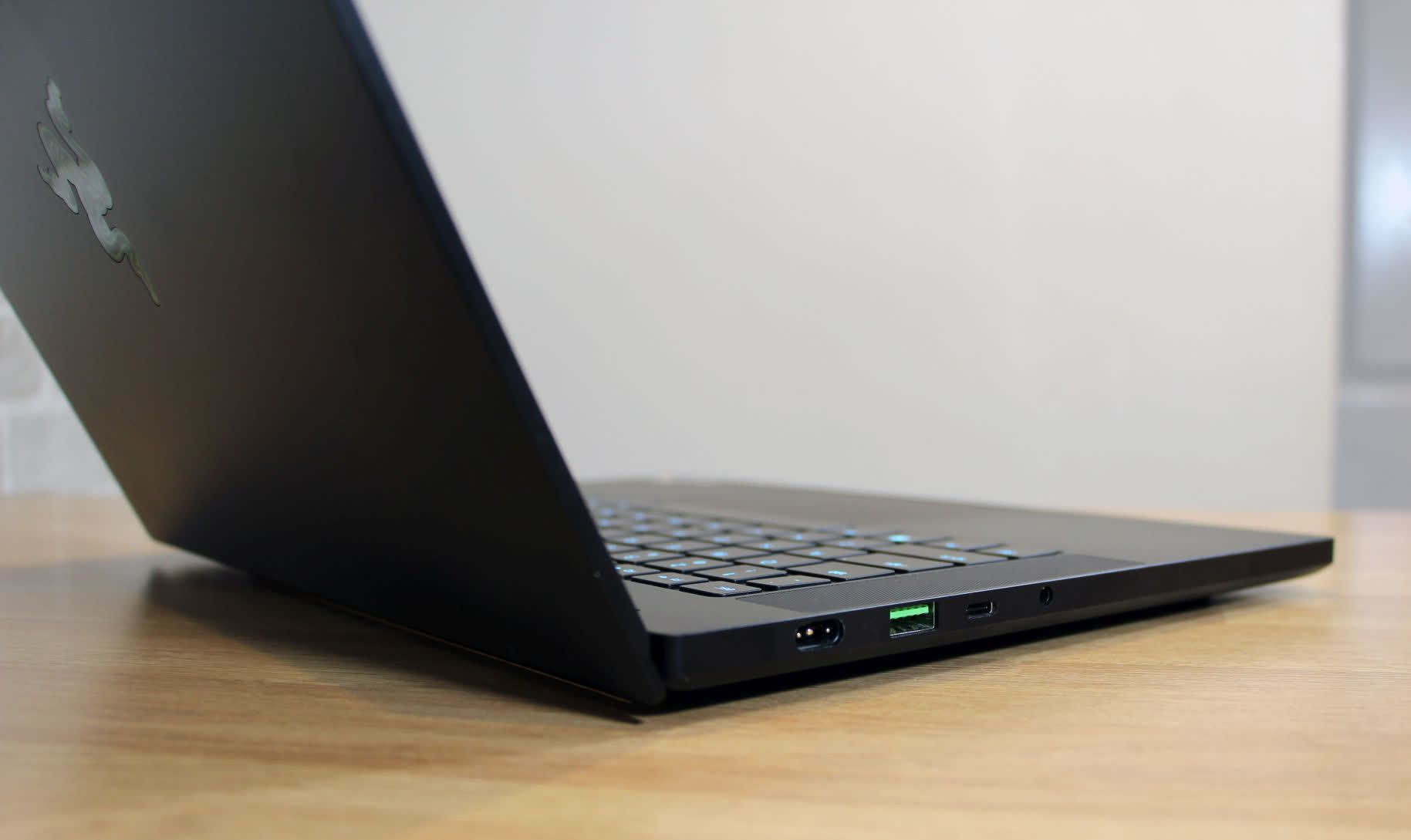
The slim, light design does mean that the graphics card and processor don't attain their full potential, though, and the Bract is sometimes hot and loud. Gaming battery life is an afterthought, and the small class factor does hateful compromises to the keyboard layout.
The Blade 14 is likewise premium-priced every bit expected. The RTX 3060-based Razer arrives at $ane,799, simply you can buy an Asus ROG Zephyrus G14 with a nearly-identical processor and graphics core for around $one,549. And if yous don't need a 14-inch display, then larger 15.6-inch and 17.3-inch laptops with an even faster GPU can oftentimes cost less.
The Razer Blade 14 is not perfect, but it crams an awful lot of gaming and application power into a small, stylish, loftier-quality build. If you lot're a fan of Razer's sleek design and want a compact gaming notebook then this is certainly worth buying.
Shopping Shortcuts
- Razer Bract 14 on Amazon, Razer.com
- GeForce RTX 3060 Laptops on Amazon
- Ryzen 9 5900HX Laptops on Amazon
Source: https://www.techspot.com/news/91033-razer-blade-14-review-gaming-laptop-style.html
Posted by: farleybuffe1971.blogspot.com


0 Response to "Razer Blade 14 Review"
Post a Comment